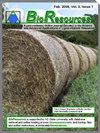玉米秸秆还田对半干旱农田土壤微生物碳利用效率和玉米产量的影响
IF 1.6
4区 农林科学
Q2 MATERIALS SCIENCE, PAPER & WOOD
引用次数: 0
摘要
土壤微生物碳利用效率(CUE)是控制陆地生态系统短期碳循环的关键参数。在为期1年的试验中,采用180标记水法研究了尿素(156 kg N hm -1)和玉米秸秆还田(9.0 t hm -1)对半干旱农田土壤微生物CUE和玉米产量的影响。在半干旱农田,施用尿素使土壤微生物CUE降低了44%,而玉米秸秆还田后土壤微生物CUE显著提高了34%。施尿素使土壤全氮含量增加23%,玉米秸秆还田使硝态氮(NO3—N)增加45%,溶解有机碳(DOC)增加53%,溶解有机氮(DON)增加122%。与不施肥相比,施尿素可使玉米株高提高4%,玉米产量提高21%。与不施肥相比,玉米秸秆还田与尿素结合减少了37%的玉米秸秆。玉米秸秆还田配施尿素与单施尿素对玉米产量无显著影响。因此,玉米秸秆还田配施尿素可能是增加土壤固碳、提高土壤肥力、保持玉米产量、恢复土壤肥力、提高生产能力的有效农艺措施。本文章由计算机程序翻译,如有差异,请以英文原文为准。
Effects of corn stalks returning on soil microbial carbon use efficiency and corn yield in semi-arid cropland
Soil microbial carbon use efficiency (CUE) is a key parameter controlling the short-term carbon (C) cycle in terrestrial ecosystems. The effect of urea application (156 kg N ha-1) and corn stalks returning (9.0 tons ha-1) on soil microbial CUE and corn yield in semi-arid cropland was studied using the 18O-labeled water approach during a one-year experiment. In semi-arid cropland, applying urea reduced soil microbial CUE by 44%, while the soil microbial CUE was increased significantly by 34% after returning corn stalks to the field. The application of urea increased the total nitrogen content of soil by 23%, and corn stalks returning further increased nitrate nitrogen (NO3–-N) by 45%, dissolved organic carbon (DOC) by 53%, and dissolved organic nitrogen (DON) by 122%. Compared with no fertilization, urea application increased the corn height by 4% and the corn yield by 21%. Corn stalks returning combined with urea reduced the corn stalks by 37% compared with no fertilizer. There was no significant difference in corn yield between corn stalks returning combined with urea and single urea application. Therefore, corn stalks returning combined with urea may be an effective agronomic measure to increase soil carbon sequestration, improve soil fertility, maintain corn yield, restore soil fertility, and improve production capacity.
求助全文
通过发布文献求助,成功后即可免费获取论文全文。
去求助
来源期刊

Bioresources
工程技术-材料科学:纸与木材
CiteScore
2.90
自引率
13.30%
发文量
397
审稿时长
2.3 months
期刊介绍:
The purpose of BioResources is to promote scientific discourse and to foster scientific developments related to sustainable manufacture involving lignocellulosic or woody biomass resources, including wood and agricultural residues. BioResources will focus on advances in science and technology. Emphasis will be placed on bioproducts, bioenergy, papermaking technology, wood products, new manufacturing materials, composite structures, and chemicals derived from lignocellulosic biomass.
 求助内容:
求助内容: 应助结果提醒方式:
应助结果提醒方式:


